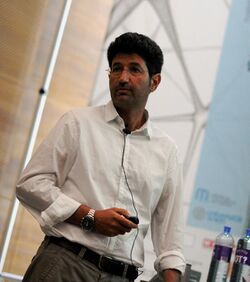Biography:Vito Latora
Vito Latora | |
|---|---|
 Vito Latora during his talk at the 2011 European Conference on Complex Systems | |
| Born | Vito Claudio Latora Italy |
| Nationality | Italian |
| Alma mater | University of Catania (Ph.D) |
| Occupation | Physicist |
| Known for | his work in the research of network theory the concept of network efficiency |
| Awards | Fellow of the Network Science Society (NetSci), 2021. |
Vito Latora is an Italian physicist, currently Professor in Applied Mathematics (Chair of Complex Systems) at the School of Mathematical Sciences of the Queen Mary University of London. He is known for his works on complex systems, in particular on the structure and dynamics of complex networks.
Career
Latora received a PhD in physics from the University of Catania in Italy for a thesis in the field of theoretical nuclear physics entitled "Multifragmentation, phase transitions and critical chaos in hot nuclei". He conducted postdoctoral research at Massachusetts Institute of Technology (MIT) in the group of Michel Baranger, in the group of Eric Heller at Harvard University, and at Paris University XI. After his postdoctoral period, he joined the department of Physics of the University of Catania as an assistant professor in 2002. Since 2012, Vito Latora is Full Professor in Applied Mathematics (Chair in Complex Systems) at the Queen Mary University of London.[1]
Research
After initial work in the field of theoretical nuclear physics, his scientific contributions have focused on statistical physics, complex systems and, especially, complex networks. Noteworthy, he has developed together with Massimo Marchiori the so-called "network efficiency",[2][3] a topological measure that accounts for the capability of a system to deliver information, or goods, spending the least amount of resources. He is also well known for his works on spatial systems and in particular on urban street networks.[4][5][6] His other contributions span a wide range of subjects ranging from statistical mechanics, to neuroscience, and social science.[7][8][9] As of March 2014, he is author of about 150 scientific papers and his h-index is equal to 50 according to Google Scholar.,[10] 38 according to Web of Science, and 37 according to Scopus.[11][12] He coauthored a review article entitled "Complex networks: Structure and dynamics"[13] published in 2006 in Physics Reports that has accrued more than 4500 citations[10] and is the most cited and downloaded article in the history of Physics Reports.[14] His work has been featured in many venues,[7][8][15][16][17][18] including being on the cover of the Physical Review Letters issue of 19 March 2010[15]
He is editor of the Journal of Complex Networks since 2013.[19] He is also member of the advisory board of Chaos,[20] a scientific journal of the American Institute of Physics.
Awards
In 2008, Latora has been awarded with the "Giovan Pietro Grimaldi Prize".[21][22][23] The motivation of the prize was: "For his works on the structure and dynamics of complex networks".
In 2021, Latora has been nominated fellow of the Network Science Society with the following citation: "For seminal work on the structure and dynamics of temporal, multilayer, and higher-order networks, and innovative applications of network science to other disciplines, including neuroscience and urban design."[24]
References
- ↑ "People - School of Mathematical Sciences". https://www.qmul.ac.uk/maths/people/.
- ↑ Latora, V.; Marchiori, M. (2001). "Efficient Behavior of Small-World Networks". Physical Review Letters 87 (19): 198701. doi:10.1103/PhysRevLett.87.198701. PMID 11690461. Bibcode: 2001PhRvL..87s8701L.
- ↑ Centrality Centrality, "Wikipedia, the free encyclopedia". Retrieved April 11, 2014.
- ↑ Matteo Bradicich, "La metamorfosi urbana dell’ultimo secolo: Esplorazione e Densificazione", "scienza.studionews24.com", (2012-03-09).
- ↑ Sarah Fecht, "Grid Unlocked: How Street Networks Evolve as Cities Grow", "Scientificamerican.com", (2012-04-06).
- ↑ "Le leggi nascoste che guidano la crescita urbana", "Le Scienze", (2012-03-03).
- ↑ 7.0 7.1 Lisa Zyga, "Scientists develop new way to decipher hidden messages in symbols", "PhysOrg.com", (2010-09-27).
- ↑ 8.0 8.1 "The Twitter Method", "physicscentral.com", (2012-07-11).
- ↑ "Mathematicians help unlock brain function", "sciencedaily.com", (2013-05-03).
- ↑ 10.0 10.1 Vito Latora profile on Google Scholar. Retrieved April 11, 2014.
- ↑ Vito Latora profile on Scopus. Retrieved April 11, 2014.
- ↑ Ivars Peterson, "Rating Researchers", "sciencenews.org", (2005-12-02).
- ↑ Boccaletti, S.; Latora, V.; Moreno, Y.; Chavez, M.; Hwang, D.-U. (2006). "Complex networks: Structure and dynamics". Physics Reports 424 (4–5): 175–308. doi:10.1016/j.physrep.2005.10.009. Bibcode: 2006PhR...424..175B.
- ↑ "Top 25 Hottest Articles: Physics and Astronomy > Physics Reports: October to December 2013". http://top25.sciencedirect.com/subject/physics-and-astronomy/21/journal/physics-reports/03701573/archive/48/.
- ↑ 15.0 15.1 Physical Review Letters 104, cover page, (2010).
- ↑ "Online ‘social petri dish’ offers insights about real-world human mobility", Santa Fe Institute Update, (Sep/Oct 2012).
- ↑ MIT Technology Review, "White Worm Could Stop Bluetooth Viruses", "technologyreview.com", (2010-12-08).
- ↑ Nature Asia, "Networks: Mapping the roads to urban growth", "natureasia.com", (2012-03-02).
- ↑ Journal of Complex Networks Editorial board. Retrieved April 11, 2014.
- ↑ List of advisory board members of Chaos Journal. Retrieved April 11, 2014.
- ↑ Terza edizione Premio Giovan Pietro Grimaldi, "fondazionegrimaldi.it", (2008-10-25).
- ↑ Università di Catania, "Premio Giovan Pietro Grimaldi", "agendabda.unict.it", (2008-10-25).
- ↑ Radio TRM, "Modica: Cerimonia di consegna del premio Giovan Pietro Grimaldi Al fisico Vito Latora che studia le reti complesse", "radiortm.it", (2008-10-25).
- ↑ "Award & Prizes - List of Network Science Society fellows". https://netscisociety.net/award-prizes/society-fellows.
External links
 |

